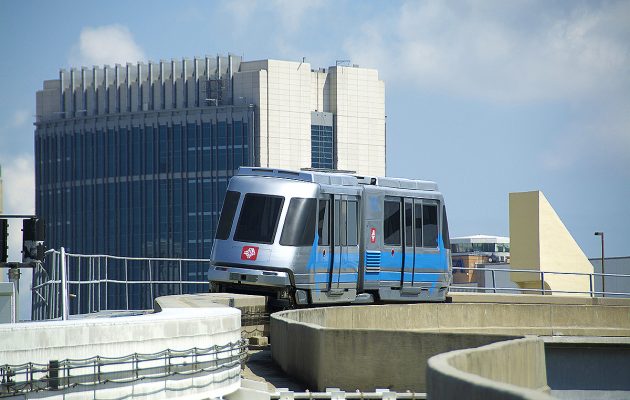JTA board to hear Skyway recommendations

Expanding the Skyway to San Marco and Riverside could be among the recommendations submitted to the Jacksonville Transportation at its Dec. 8 board meeting.
For the past year, a subcommittee has been studying how to modernize the 27-year-old people mover system.
Public sentiment is strong for extending the system to Jacksonville’s sports complexes, San Marco and Riverside, but there are many variables to consider: should the new cars be elevated or street level, manned or driverless, third rail or battery powered.
Already the driverless cars are sporting a new look – an exterior “wrap” with a blue arrow and the JTA logo – but the technology that was state-of-the-art when the system came on line in the 1990s is now obsolete.
The existing Skyway could last another 50 years with proper maintenance, but parts are no longer available for the 10 driverless trains, said Brad Thoburn, vice president of long-range planning and system development at JTA.
So the JTA subcommittee has been looking at other options including upgrading to modern people mover vehicles, a rapid transit system, smaller cars that could operate on the street or on rail, and the option of a street-level driverless system.
The board also will be looking at expanding routes to Riverside to include Brooklyn Station, 5 Points and Riverside Arts Market; San Marco to include Baptist Medical Center, RiverPlace, Kings Street and The District, when it is built on the Southbank; the stadium complex, and UF Health by way of Main Street.
JTA has been seeking public input through forums, like one Nov. 15 at the downtown library, and an online survey.
However, there’s no secret about what the public would like to see happen, Thoburn said. About 83 percent want the Skyway to go to the stadium complex, 79 percent to Brooklyn and 66 percent to San Marco.
“The next thing people want to know is how are we going to pay for it,” Thoburn said. “We are not there yet. There are a lot of possibilities, including public/private partnerships and grants.”
The original system cost $182 million and a future system would likely far exceed that.
The toughest challenge facing JTA is trying to see into the future, anticipating technological developments and population growth.
“Technology is rapidly changing, especially the autonomous [driverless] vehicles,” Thoburn said. It’s the “vehicle of the future,” with so many unknowns.
Population trends are another unknown. The subcommittee has projected that by 2040 Downtown, Brooklyn and the Southbank could be high-density residential areas with an estimated 50 people per acre.
“We need a broader reach,” Thoburn said. “The new development [Brooklyn Station] is just beyond our reach.”
The current system provides 1.2 million rides a year, running a 25-mile circuit of Downtown and San Marco on weekdays and on weekends for special events.
Tom and Maureen Hermann, who live in Riverside, ride the Skyway occasionally, mostly to entertain their grandkids.
“I’d like to use it more but I don’t know how to access it,” Tom Hermann said. “It’s really not on my radar.”
The Hermanns attended a public forum on the Skyway last month to see what was being considered.
If it was easier to access, the Hermanns said they would use it to go to the symphony, Hemming Park, MOCA and, if it were extended, the Baseball Grounds.
Wende Wilson, who lives in 5 Points, said she rarely uses the Skyway, “but I would if it went somewhere I want to go. I would love to sell my car.”
By Lilla Ross
Resident Community News






